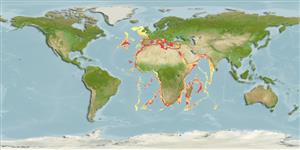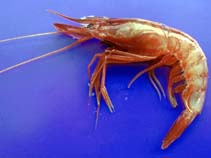Aristeus antennatus (Risso, 1816)
Blue and red shrimp| Native range | All suitable habitat | Point map | Year 2050 |

|
| This map was computer-generated and has not yet been reviewed. |
| Aristeus antennatus AquaMaps Data sources: GBIF OBIS |
Classification / Names Common names | Synonyms | CoL | ITIS | WoRMS
Malacostraca | Decapoda | Aristeidae
Environment: milieu / climate zone / depth range / distribution range Ecology
Benthic; depth range 80 - 3300 m (Ref. 127635), usually 350 - 800 m (Ref. 80214). Tropical, preferred 19°C (Ref. 107945); 49°N - 30°S, 41°W - 75°E
Distribution Countries | FAO areas | Ecosystems | Occurrences | Introductions
Eastern Atlantic, Mediterranean and Western Indian Ocean: from Brazil to France, south to Natal, South Africa and east to Maldives.
Length at first maturity / Size / Weight / Age
Maturity: Lm 3.2 range ? - ? cm Max length : 22.0 cm TL male/unsexed; (Ref. 8); 7.1 cm CL (female); max. reported age: 6 years (Ref. 80242)
Demersal (Ref. 80214). Maximum length for females from Ref. 80234. Demersal on muddy bottoms of slopes of continental shelf, in zones close to submarine canyons. Moves from depths of 200 m during the night to 800 m during the day, and changes location within the year (Ref. 80214). Feeds on small benthic invertebrates mainly crustaceans and polychaetes and also carrion (Ref. 434).
Life cycle and mating behavior Maturity | Reproduction | Spawning | Eggs | Fecundity | Larvae
Members of the order Decapoda are mostly gonochoric. Mating behavior: Precopulatory courtship ritual is common (through olfactory and tactile cues); usually indirect sperm transfer.
Main reference
References | Coordinator | Collaborators
Holthuis, L.B. 1980. (Ref. 8)
IUCN Red List Status (Ref. 130435)
CITES status (Ref. 108899)
Not Evaluated
CMS (Ref. 116361)
Not Evaluated
Threat to humans
Human uses
Fisheries: highly commercial
FAO - Fisheries: landings, species profile | FIRMS (Stock assessments) | FishSource | Sea Around Us
Tools
More information
Internet sources
BHL | BOLD Systems | CISTI | DiscoverLife | FAO(Fisheries: species profile; publication : search) | Fishipedia | GenBank (genome, nucleotide) | GloBI | Gomexsi | Google Books | Google Scholar | Google | PubMed | Tree of Life | Wikipedia (Go, Search) | Zoological Record
Estimates based on models
Preferred temperature
(Ref. 115969): 6.6 - 18.3, mean 13.3 (based on 351 cells).
Resilience
(Ref. 69278):
High, minimum population doubling time less than 15 months (K=0.14-0.99; tmax=6).
Prior r = 0.66, 95% CL = 0.44 - 0.99, Based on 7 full stock assessments.
Nutrients: Calcium = 109 [35, 184] mg/100g; Iron = 1.59 [1.21, 1.97] mg/100g; Protein = 20.2 [19.2, 21.3] %; Omega3 = 0.285 [0.185, 0.386] g/100g; Selenium = 48.3 [-31.7, 128.3] μg/100g; VitaminA = 0 μg/100g; Zinc = 1.79 [1.17, 2.40] mg/100g (wet weight).



